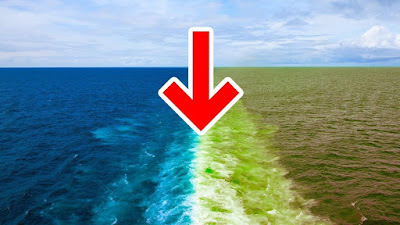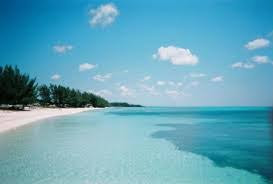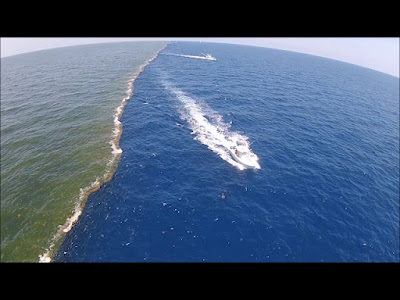Masses d'eau non conformes:-
 |
| Masses d'eau |
At the point when you take a gander at the oceans and seas on the guide, you may feel that they simply stream into one another. It appears as though there’s just a single large sea, and individuals just gave various names to its parts. All things considered, you’ll be flabbergasted at how clear the outskirts between them are! The fringe between two Water Bodies the Pacific and Atlantic seas resembles a line between 2 universes. It looks as though the two seas meet at an undetectable divider which doesn’t let them stream into one another and blend their waters. Why in the world does it occur? We know without a doubt there is no undetectable divider inside, and water will be water. What could meddle with its blending? Indeed water in Water Bodies can be diverse as well. The Atlantic and the Pacific seas have the distinctive thickness and compound make-up, the degree of saltiness and different characteristics. One can see by their shading that they are a long way from being the equivalent. The fringes between two water bodies with various physical and organic attributes are known as sea clines. Haloclines – fringes between waters with various saltiness – are the most terrific, and this is the thing that we see when the Atlantic and the Pacific seas meet. The acclaimed pilgrim Jacques Cousteau discovered this when he was profound making a plunge the Strait of Gibraltar. The layers of water with various saltiness appeared as though they were partitioned with a straightforward film, and each layer had its own widely varied vegetation.
Haloclines
 |
| Masses d'eau |
Haloclines show up when water in one sea or ocean is, in any event, multiple times saltier than in the other. You can make a halocline at home on the off chance that you pour some seawater or shaded salty water in a glass and afterwards include some new water top of it. The main contrast is that your halocline will be flat, and sea haloclines are vertical. In the event that you recollect two or three essential things from material science, you may contend that a denser fluid ought to at last end up lower and less thick higher. In the event that that was genuine, the fringe between the two seas would dislike a vertical line yet as a flat one, and the distinction between their saltiness would turn out to be more subtle the closer they found a good pace. So for what reason doesn’t it occur here? All things considered, first, the distinction in the thickness of water of the two seas isn’t that incredible for one of them to get down and the other to ascend. But then it’s sufficient not to allow them to blend. All things considered, another explanation is latency. One of the inertial powers known as Coriolis power impacts objects when they are moving in the arrangement of tomahawks which, in its turn, is moving as well.
In more straightforward words, the Earth is moving, and all the moving articles on it will be followed up on by Coriolis power, going astray from their course. Therefore, the articles on the Earth surface don’t move straight on yet go astray in clockwise request in the Northern half of the globe and counterclockwise in the Southern. Yet, the Earth is moving gradually, it takes the planet an entire day to make a round trip around its hub. That is the reason the Coriolis impact gets evident just a prolonged stretch of time interims: with tornados or sea streams. What’s more, this is the reason the heading of streams in the Atlantic and Pacific seas is extraordinary. It additionally doesn’t allow them to blend. Another significant contrast between the two seas’ water is the quality of atoms’ association or surface rigidity. On account of this quality, particles of an issue hold to one another. The two seas have a very surprising surface elasticity, and it additionally doesn’t allow them to blend.
Possibly they could step by step begin blending in with time, however as the streams in them have inverse headings, they simply don’t have the opportunity to do this. We believe that it’s simply water in the two seas( water bodies ), yet its different particles meet for only a short minute and afterwards become really excited with the sea stream. Wouldn’t you say, however, that solitary the Atlantic and Pacific seas don’t manage everything well with one another! There are a ton of spots on the planet where water in the two oceans or streams doesn’t blend. There are additionally thermoclines – outskirts between water of various temperatures, similar to the warm water of Gulf Stream and a lot colder North Atlantic Ocean. Chemoclines are the most astounding ones. These are fringes between waters having diverse microclimate and substance make-up. The Sargasso Sea is the greatest and most generally known chemocline. It is an ocean inside the Atlantic Ocean which has no shores yet you have zero chance not to see it. We should view the other most marvellous clines on earth.
Masses d'eau Qui ne se rencontrent pas :-
 |
| Masses d'eau |
#1. The North and Baltic Seas These two oceans meet close to the Danish city of Skagen. The water in them doesn’t blend as a result of various thickness. Now and then you can see the rushes of the 2 oceans conflict into one another, making froth. But then their water blends steadily, that is the reason the Baltic Sea is marginally saline. On the off chance that there had been no water coming to it from the North Sea, it would’ve been a colossal freshwater lake.
#2. The Mediterranean Sea and the Atlantic Ocean. They meet at the Strait of Gibraltar and have an alternate thickness and saltiness, so their water doesn’t blend as well.#3. La mer des Caraïbes et l'océan Atlantique se rejoignent près des Antilles et semblent avoir été peints de différentes nuances de bleu. L'île d'Eleuthera, dans les Bahamas, se trouve quelque part ailleurs où ces deux mers se rencontrent. L'eau de la mer des Caraïbes est turquoise et l'eau de l'océan Atlantique est bleu terne.
#4. Le fleuve Surinam et l'océan Atlantique se rencontrent près de Paramaribo en Amérique du Sud.
 |
| Masses d'eau |
#5. Le fleuve Uruguay et son afflux Ces deux cours d'eau se rencontrent dans la région de Misiones en Argentine. L'un d'eux est nettoyé pour être utilisé en horticulture, et l'autre devient pratiquement rouge à la lumière de la terre arable pendant les saisons orageuses.
#6. The Rio Negro and Solimões Rivers (some portion of the Amazon River) 6 miles from Manaus in Brazil, Rio Negro and Solimoes waterways low into one another yet don’t blend for about 2.5 miles. The Rio Negro is dim and Solimoes – light, they have an alternate temperature and speed of the stream.
#7. Moselle et Rhin Ils se rencontrent à Coblence, en Allemagne. Le Rhin a des eaux plus claires et la Moselle des eaux plus foncées.
#8. Ilz, Danube et Inn L'intersection de ces trois cours d'eau se trouve à Passau, en Allemagne. L'Ilz est un petit cours d'eau de montagne d'un côté, le Danube est au centre et l'Inn est le cours d'eau léger d'un côté. L'Inn est ici plus étendu que le Danube, mais il est en même temps son afflux.
#9. Les rivières Alaknanda et Bhagirathi se rencontrent en Inde. L'Alaknanda est sombre et la Bhagirathi est claire.
#10. Irtysh and Ulba stream into one another in Kazakhstan close to the city whose name you’ll always be unable to articulate, nor will I. You give it a shot. (Ust’- Kamenogorsk.) The Irtysh has clean water and Ulba – shady.
 |
| Masses d'eau |
#11. Les fleuves Jialing et Yangtze se croisent à Chongqing, en Chine. Le Jialing est immaculé et le Yangtze est de couleur foncée.
#12. Irtych et Om Ces deux cours d'eau se rejoignent à Omsk, en Russie. L'Irtych est ombragée et l'Om est pure et franche.
#13. Chuya and Katun waterways(water bodies) meet in the Altai Republic, Russia. The water of the Chuya has an abnormal shady white shading here and looks thick and thick. Katun is spotless and turquoise. Streaming into one another they structure a solitary two-hued stream that doesn’t blend for quite a while.
#14. The Green and Colorado waterways. The spot of their intersection in Canyonlands National Park in Utah, USA. Colorado is darker and Green is – that’s right, green. The passages of these streams experience rocks with various synthetic make-up, (water bodies that are the reason they have such a major difference of hues.
#15. The Rhone and Arve waterways They stream into one another in Geneva, Switzerland. The Rhone is an unadulterated waterway that streams out of the pool of Geneva, the Arve is overcast as it gets its water from icy masses of the Chamonix valley. Anyway, the water you consider this water? Obviously it’s a terrible joke, similar to a ton of my awful ways to express those waterway names.
Pour en savoir plus sur ce type de contenu, visitez le site Connaît le kit







